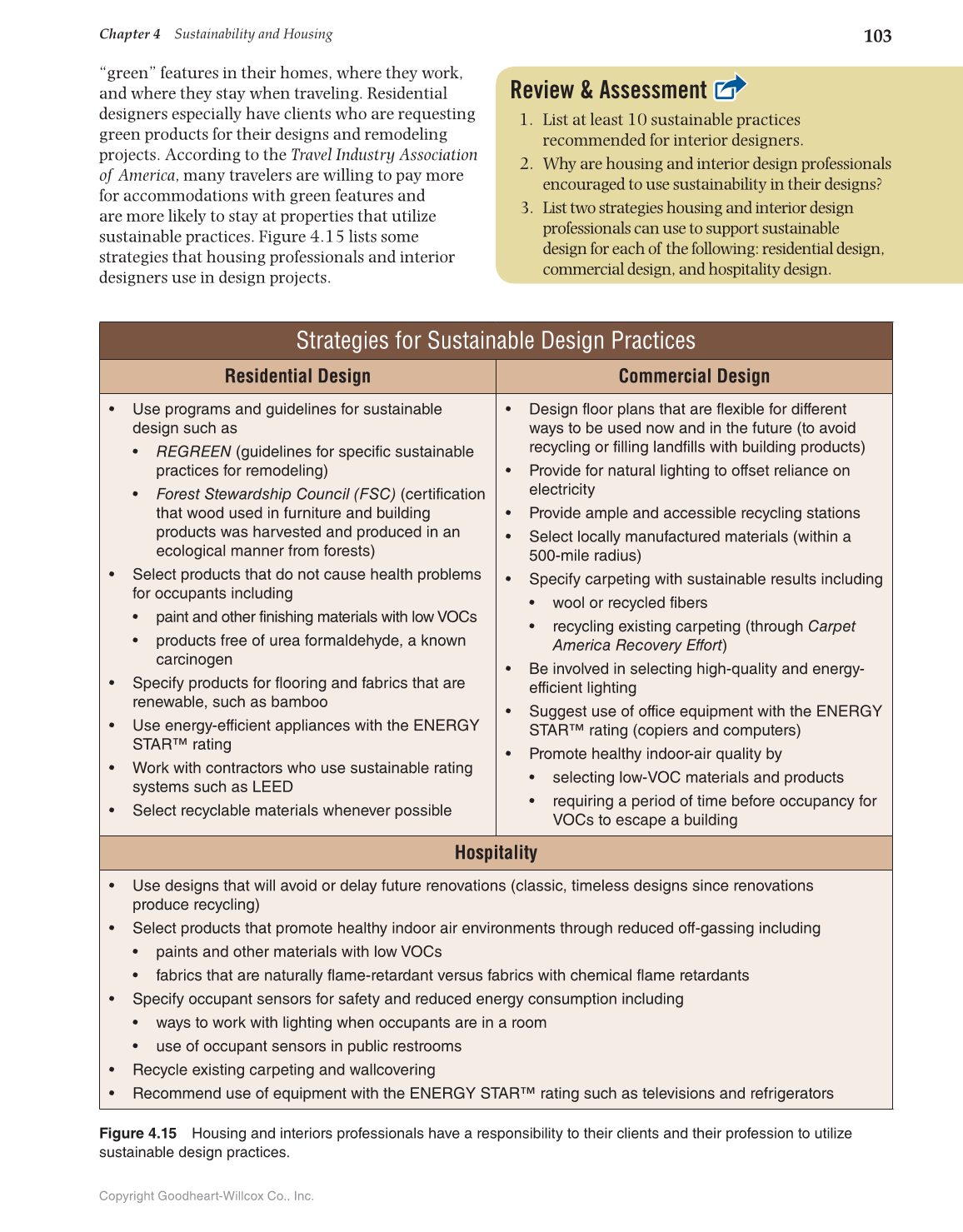103
Chapter 4 Sustainability and Housing
Copyright Goodheart-Willcox Co., Inc.
“green” features in their homes, where they work,
and where they stay when traveling. Residential
designers especially have clients who are requesting
green products for their designs and remodeling
projects. According to the Travel Industry Association
of America, many travelers are willing to pay more
for accommodations with green features and
are more likely to stay at properties that utilize
sustainable practices. Figure 4.15 lists some
strategies that housing professionals and interior
designers use in design projects.
Review & Assessment
1. List at least 10 sustainable practices
recommended for interior designers.
2. Why are housing and interior design professionals
encouraged to use sustainability in their designs?
3. List two strategies housing and interior design
professionals can use to support sustainable
design for each of the following: residential design,
commercial design, and hospitality design.
Strategies for Sustainable Design Practices
Residential Design Commercial Design
• Use programs and guidelines for sustainable
design such as
• REGREEN (guidelines for specific sustainable
practices for remodeling)
• Forest Stewardship Council (FSC) (certification
that wood used in furniture and building
products was harvested and produced in an
ecological manner from forests)
• Select products that do not cause health problems
for occupants including
• paint and other finishing materials with low VOCs
• products free of urea formaldehyde, a known
carcinogen
• Specify products for flooring and fabrics that are
renewable, such as bamboo
• Use energy-efficient appliances with the ENERGY
STAR™ rating
• Work with contractors who use sustainable rating
systems such as LEED
• Select recyclable materials whenever possible
• Design floor plans that are flexible for different
ways to be used now and in the future (to avoid
recycling or filling landfills with building products)
• Provide for natural lighting to offset reliance on
electricity
• Provide ample and accessible recycling stations
• Select locally manufactured materials (within a
500-mile radius)
• Specify carpeting with sustainable results including
• wool or recycled fibers
• recycling existing carpeting (through Carpet
America Recovery Effort)
• Be involved in selecting high-quality and energy-
efficient lighting
• Suggest use of office equipment with the ENERGY
STAR™ rating (copiers and computers)
• Promote healthy indoor-air quality by
• selecting low-VOC materials and products
• requiring a period of time before occupancy for
VOCs to escape a building
Hospitality
• Use designs that will avoid or delay future renovations (classic, timeless designs since renovations
produce recycling)
• Select products that promote healthy indoor air environments through reduced off-gassing including
• paints and other materials with low VOCs
• fabrics that are naturally flame-retardant versus fabrics with chemical flame retardants
• Specify occupant sensors for safety and reduced energy consumption including
• ways to work with lighting when occupants are in a room
• use of occupant sensors in public restrooms
• Recycle existing carpeting and wallcovering
• Recommend use of equipment with the ENERGY STAR™ rating such as televisions and refrigerators
Figure 4.15 Housing and interiors professionals have a responsibility to their clients and their profession to utilize
sustainable design practices.
